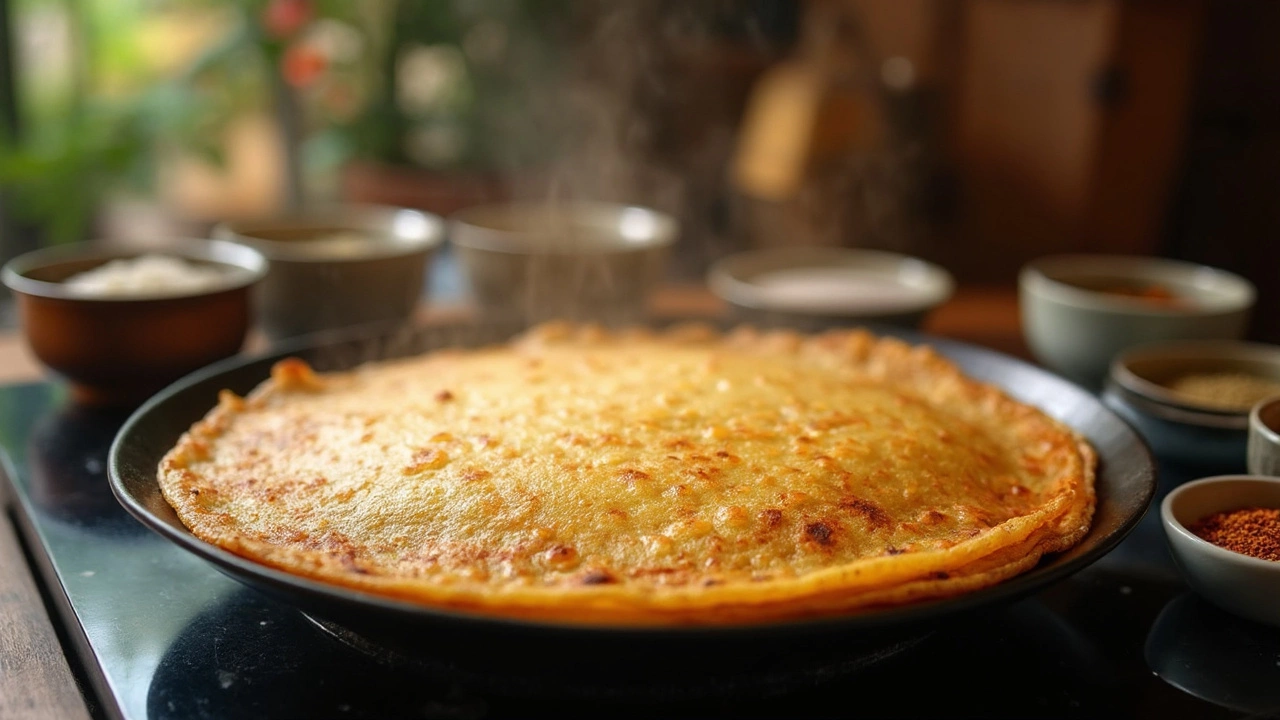Fast Dosa Batter: No Yeast, No Problem!
 Feb, 11 2025
Feb, 11 2025
Craving a crispy dosa but short on time? You're not alone! Luckily, you don’t have to wait forever to get that perfect batter without yeast. Let's dive into some easy tips to speed things up while keeping it delicious as ever.
First off, let’s touch on the basics. Dosa batter typically requires rice and urad dal, blended and left to ferment. This fermentation process is what gives dosas their signature tang and fluffiness. But who has time to wait? Not everyone wants to leave their batter in the corner overnight, hoping it rises all by itself.
Here’s a little-known trick: temperature is your friend. Try placing the batter in a warm spot, like an oven with the light on. This can significantly cut down fermentation time, getting you closer to dosa heaven pronto.
For those who want to dodge yeast altogether, consider using flattened rice, or poha. Adding this into your batter can help the fermentation process along naturally. Plus, it's a pantry staple in many homes!
- Understanding Dosa Batter Basics
- Quick Fermentation Techniques
- No Yeast Alternatives
- Practical Tips for Consistent Results
Understanding Dosa Batter Basics
Alright, let's break this down! Making a good dosa starts with understanding the dosa batter fermentation essentials. At its core, you have rice and urad dal, which need to be soaked, ground, and then fermented. It sounds simple, but each step plays a critical role in getting that perfect dosa texture.
Why Rice and Urad Dal?
The combination of rice and urad dal isn't just a random choice. Rice provides the necessary carbohydrates, while urad dal offers proteins and acts as a fermenting agent. This mix is essential to create the right fermentation process, which gives dosas their unique taste and texture.
Perfecting the Soak
Always soak your rice and dal in separate bowls for about 4-6 hours. This not only softens them but also kick-starts the fermentation process. The longer they soak, the easier they grind, and the better your batter turns out.
Get the Grind Right
Grinding is where most beginners face hiccups. You need a smooth yet slightly grainy batter for the right texture. Add water cautiously while grinding to ensure it's neither too thick nor too runny. Aim for a consistency where it can coat the back of a spoon but still drip off slowly.
The Fermentation Stage
Once your ingredients are soaked and ground, fermentation is the next big step. Traditionally, batter is left overnight. But if you're looking for quick dosa tips, adjusting the environment helps. A warm spot speeds things up – ideal if you're in a rush!
Here’s a neat little pro-tip: mix a bit of salt right before fermentation. It might seem counterintuitive, but it can actually help control the fermentation pace and improve flavor.
With these basics in hand, you’re well on your way to making perfect dosas even without yeast. Keep these tips handy, and practice makes perfect!
Quick Fermentation Techniques
In the rush of day-to-day life, waiting for dosa batter to ferment can be a hassle. But don't worry, I've got some quick methods to speed up fermentation without using any yeast.
Use the Right Equipment
First things first, the container you choose can make a difference. Use a large bowl to allow the batter enough space to expand. Leave about one-third of the bowl empty as the batter tends to rise during fermentation.
Warmer Climate Wins
A warm environment is key to quick dosa batter fermentation. If it's not warm enough, consider turning on the oven light or placing the mixture near a heater. An average temperature of 30°C (86°F) is optimal for good results.
Quick Tips to Make It Work
- Add a tablespoon of sugar to help speed up natural yeast activity without needing commercial yeast.
- Use slightly warm water when grinding the rice and dal to kickstart the fermentation process.
- Mix in a handful of soaked poha or cooked rice. These ingredients naturally ferment fast and help the overall process.
Pro Tip from the Kitchen
If the house is cold, keep the batter in an Instant Pot on the yogurt setting. It works wonders. — Shashi Kumar, Culinary Expert
By following these tips, you won't have to wait forever to enjoy those scrumptious, crispy dosa! Easy peasy, right?

No Yeast Alternatives
So, you want to make dosa batter but skip the yeast? You're in luck! There are plenty of ways to get that perfect fermentation without relying on yeast.
Using Flattened Rice (Poha)
Poha can be your secret weapon for those crispy, tangy dosas. Adding a handful of soaked flattened rice to your regular rice and dal mix keeps the fermentation process ticking along nicely.
- Start by soaking a cup of rice and a cup of urad dal in separate bowls for about 4-6 hours.
- Soak a small handful of poha for about 15 minutes just before blending.
- Blend them all together with a bit of water till smooth, and let it ferment in a warm spot.
This extra ingredient can shave hours off your wait time!
Boosting Fermentation with Fenugreek Seeds
Fenugreek seeds (methi) are another great alternative to yeast. They increase the nutritional value and aid in faster fermentation.
- Add about a teaspoon of fenugreek seeds to your rice or dal when you soak them.
- This simple addition introduces natural probiotics that help speed up the fermentation process and enhance the flavor.
The Quick-Sour Curds Hack
If you’re really in a rush, try the curd trick. Adding a spoonful of sour curd can help mimic the tanginess of fermented batter.
- You can mix a spoonful of curd into the batter before blending. Just watch out for the consistency!
- The naturally occurring bacteria in curds helps kickstart fermentation while adding flavor.
With these trusty alternatives, you’re all set for a batch of mouth-watering dosa batter—no yeast fuss, guaranteed!
Practical Tips for Consistent Results
Getting the perfect dosa batter fermentation can feel a bit like magic, but really, it comes down to some solid tips and tricks. Let’s break it down so you can consistently whip up delicious dosas with ease.
Fine-Tune Rice and Dal Ratio
The ratio of rice to urad dal is crucial. A 3:1 or 4:1 ratio usually works best, giving you that perfect blend of crispiness and softness. It’s not just about mixing but balancing for flavor and texture. Remember, soaked and ground separately before mixing helps each to do its job better.
Blend to Perfection
The way you grind your batter makes a huge difference. Hum your favorite tune and give it some time! Start by grinding urad dal until it's silky and smooth, ideally in a wet grinder. Rice should be a bit grainier, adding that crunch we love. Combine them and give a quick whirl just to mix.
“Consistency in dosa batter comes from patience. Give it time, and always trust your gut instinct.” - Chef Rekha Sharma
Keep an Eye on Temperature
Temperature is key to quick fermentation. If it's cooler outside, your oven's light can create the right environment. In warmer weather, just leave it in a corner. This small adjustment can be a game changer in speeding up the process, making those quick dosa tips a reliable go-to.
Monitor and Adjust
While waiting, be vigilant. If your batter doubles in size, it's good to go! Too quick? Toss in a bit of salt to slow it down. No bubbling action yet? A pinch of sugar can sweeten the deal and kickstart fermentation.
Table of Optimal Fermentation Temperatures
| Temperature (°C) | Fermentation Time |
|---|---|
| 25-30 | 8-10 hours |
| 20-25 | 12-14 hours |
| 15-20 | 14-16 hours |
These tips might seem simple but they make all the difference. Experiment a bit and see what gets you the best results in your kitchen. Happy dosa making!